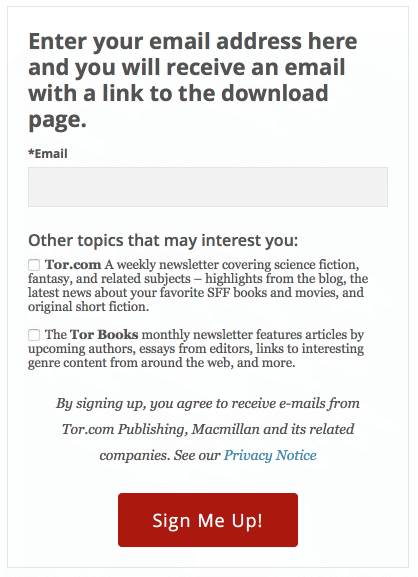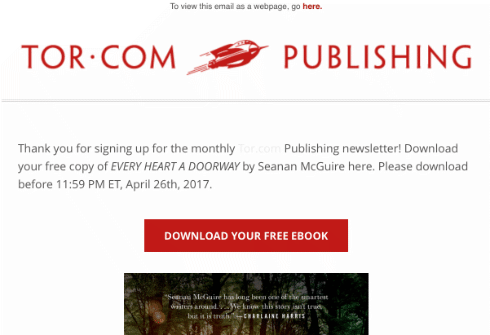What’s the best opt-in method?
Kickbox interviewed a bunch of us to find out what methods of opt-in we recommend. Go check it out.
What’s your favourite method of opt-in?
Kickbox interviewed a bunch of us to find out what methods of opt-in we recommend. Go check it out.
What’s your favourite method of opt-in?
An email address was entered into our website
An email address was associated with a purchase on our website.
Read MoreWe often talk about confirmed opt-in (aka “closed-loop opt-in” or “double opt-in”) as the gold standard for address acquisition for permission-based mail.
It’s not the only way to gather permission, and in some ways it’s a rather blunt tool that can discourage people from completing a sign-up process if it’s done badly – the confirmation email isn’t sent immediately, it goes to the recipients spam folder, they don’t have any reason to go and look for it, …
When it’s done well, though, it’s excellent.
Tor.com, the site for science-fiction and fantasy operated by publisher Macmillan, just did it very well with an ebook giveaway.
Last year they published Every Heart a Doorway, a novella that won several awards and caused quite a bit of buzz in the SFF community, partly because it’s very good and partly because it’s author, Seanan McGuire, has some serious social media chops. The sequel, Down among the Sticks and Bones, is being released in the next month or two.
Perfect timing for a time-limited giveaway of the first book, tied to signing up for their mailing list.
The signup form is on a page dedicated to the giveaway that talks about the book and sets some expectations about the mailing list. The form itself makes it very clear that you’ll need to enter a real email address to get the ebook download, so me@privacy.net is less likely to subscribe.
People aren’t required to sign up for the mailing lists to get the download. This isn’t a barter, a mailing list signup for a book, rather it’s putting the opportunity to sign up for the mailing lists in front of people who are self-selected to be interested in the content. That probably reduces the “how many people signed up” metric somewhat, but I bet the “how many new subscribers are still signed up in a month” numbers will look very healthy.
It provides some options. Do you want weekly content? Monthly? Both? You know that you’re not going to end up on a thrice-daily list from Macmillan and all their affiliates.
The confirmation email landed in my inbox within a few seconds after I clicked the “Sign Me Up” button. That’s important. If it takes even a few minutes I might have moved on, and wouldn’t be looking for the confirmation mail if it had ended up in my bulk folder.
And the confirmation mail isn’t a “click here to confirm your subscription” yawnfest. The subject line is “Download EVERY HEART A DOORWAY by Seanan McGuire Now” and the body content is on-brand and includes the front cover of the book.
Way more compelling.
It’s still solid informed consent from me, and confirmation that I, the owner of the email address, want on the list. (And, yes, the download link has 56 bytes of opaque hex-encoded data in it, so I know they’re tracking that.)
This is how it should be done.
(And, if you like fantasy you should head over to Tor and sign up for their promo. Seanan writes some amazing things, and I’m not just saying that because she’s a friend.)
It’s that time again… here’s a look at our last month of blog posts. We find it useful to recap each month, both to track trends and issues in email delivery and to provide a handy summary for those who aren’t following along breathlessly every single day. Let us know if you find it useful too!
As always, I wrote about email filters. It’s so important to recognize that filters aren’t arbitrary — they’re detailed instructions that help meet specific user needs, and the more you are cognizant of that, the better you’ll be able to work with them. Additionally, filters aren’t perfect and likely never will be. False positives and false negatives are frustrating, but as long as spam is still a viable business for spammers, they’ll continue to figure out how to work around filters. As such, we can’t expect filters to be 100% accurate in determining what constitutes wanted and unwanted mail.
Part of this, of course, is due to the problem of fraudulent signups. Companies aren’t particularly vigilant about address acquisition and hygiene, and as a result, they’ll claim you “signed up” for their email when you did not. Some people believe that a confirmed opt-in (COI) will solve this problem, but our experience is companies are reluctant to leave revenue on the table, and that they will continue to mail to addresses that have not confirmed.
Address sharing and co-reg is also part of the problem. As we saw in the extensive RCM data breach, many major brands continue to work with third-party senders to send mail in ways that are quite clearly spam. And in more criminal activity, I looked at the rise of botnets and how some of those criminals were brought to justice. In other justice news, there’s been an indictment in the Yahoo breach and another CASL enforcement action.
I wrote a post about bounce handling and “relaying denied” error messages, which are quite rare. It’s useful to have an understanding of these and other error messages, since bounces are sometimes indicative of a larger technical issue, such as when AOL accidentally bounced all messages for a short period last week. Speaking of AOL, we noted that there’s no official timeline for the move from Verizon addresses to AOL addresses following the 2015 acquisition, but it may be worth considering asking your customers to update their addresses.
Spam and filters aren’t the only factors of course. It can be challenging to figure out the multiple factors that make up the black box of delivery. And of course, the most important part of delivery continues to be engagement, engagement, engagement.
I wrote a few posts this month on why I do what I do, and why it’s so important to me. First, I wrote about A Day Without A Woman, and my choice not to participate in offering advice and guidance for that day. The truth is that I enjoy sharing what I know and helping people solve problems. I was honored to be named one of 11 Innovators in Email, and I know that my volunteer work in the industry and my unpaid blogging work is a big part of that. It may sound corny, but I really do believe we are on the front lines of the fight of good vs. evil online, and despite the distractions of politics and world events, we must all continue to do our part.